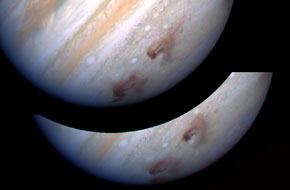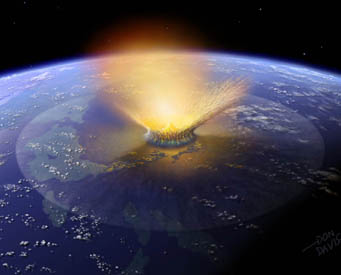
Jupiter can act as a shield, soaking up impacts as happened in 1994 with comet Shoemaker-Levy 9.
Jupiter is known as many things: king of the planets, an impressive gas giant, defender of the inner solar system. This last notion comes from the idea that Jupiter is so massive that its gravitational influence deflects objects like comets, which, as they spiral toward the Sun, could potentially hit inner planets such as the Earth.
Without Jupiter acting as a "cosmic vacuum cleaner" sucking up these dangerous objects, there would be so many catastrophic impacts that life probably wouldn't have evolved on the Earth and we wouldn't be here today. At least, this is the commonly accepted wisdom. Like so many topics in astrobiology, it isn't as straightforward as it first seems. Jonti Horner and a team from the UK's Open University have been addressing the question of whether Jupiter is our friend or foe.
"This vacuum cleaner idea goes back to when the long-period comets coming in from the Oort Cloud were viewed as being the only significant impact risk," says Horner. "In the 1950s there were only one or two near-Earth asteroids known, so they were viewed as oddities."
Astronomers in the 1950s realized that comets were approaching the solar system from extreme distances — so far away that the Sun, Jupiter, and other planets were essentially a single point-source of gravitational influence. When the comets got close enough to resolve the Sun and Jupiter as separate objects, they then had different forces pulling at them, resulting in a change of direction.

A team of scientists propose that a large fragment from the Baptistina breakup eventually slammed into Earth 65 million years ago, triggering a global biological catastrophe.
Don Davis
"The comets get a very slight kick, an increase in energy, from Jupiter," says Horner. "For these comets, Jupiter stops them from coming back time and time again; Jupiter makes them leave. The great majority of long-period comets only come through once but they have a very small chance of hitting the Earth."
Since the 1950s, scientists have discovered more objects in the solar system, and they say many of them could collide with us. The objects are found primarily in the asteroid belt between Mars and Jupiter, but a few remnants from the planet formation era 4.6 billion years ago are dotted around the solar system. Horner believes it's these two groups of asteroids — and not comets — that are most dangerous to life on Earth.
"Occasionally there are collisions between these objects, and when they collide they get nudged onto different orbits and into unstable regions," says Horner. "Then Jupiter can start to perturb them and nudge them around. That's where we get the near-Earth asteroids from, and these are now perceived to be the greatest risk to our planet."
But just how common are these impacts? Do they occur often enough to endanger life? Horner and many other scientists believe so. Part of the danger depends on the size of the object. It's been estimated that about 75 million meteors hit the Earth every day, but because they are typically no bigger than a grain of sand, they'll just leave a pretty trail in the night sky. It's not these tiny meteors that concern Horner, it's their larger relatives that inhabit the solar system.
"The bigger they are, the less frequent the impacts are, but the more interesting they become, and certainly more threatening," says Horner. "A figure that's banded around is that a one kilometer-sized object would hit the Earth on average every 300,000 years. A one kilometer object is the threshold between being a locally damaging event and a globally damaging event. Bigger than this, and you get a lot of people falling over."
It's not just the size or frequency of impacts that has to be taken into consideration. Speed also is an important factor. Doubling the velocity can put four times more energy into the impact.
"The long-period comets are more of a threat at a given size because they hit harder and faster," says Horner. "With the near-Earth asteroids, you'd need a bigger object hitting us to have the same amount of devastation."
Horner and his team reasoned that for a planet to be habitable over appreciable periods of time, it would have to somehow avoid impacts of extinction-level size and speed. However, smaller and slower impacts also may stop life from developing if they hit regularly enough.
Despite the apocalyptic potential of asteroids and comets, Horner's research suggests we're more likely to find habitable worlds elsewhere in the galaxy. He says that the presence of a gas giant planet isn't as important as everyone thinks, and that means there is greater wiggle room in our definition of what makes a solar system habitable. He also theorizes that impacts may not always be detrimental to life — in fact, they may be essential.
"It may be that if you have too few impacts, life will stagnate," he says. "It may even be that our Earth is not the ideal in terms of intelligent life evolving. Maybe we have too few impacts, which is why it's taken us four and a half billion years to get here."
However, until life is found elsewhere scientists can only guess at what environmental conditions are best for intelligent life to evolve and persist. In the meantime, Horner's results may cause us to alter our ideas of where life could form, and the conditions under which it can develop. The next step in his research is to look at the effect of smaller planets, such as Neptune. Could it be that they have more of an influence on our own world than we currently believe? Horner also hopes to use complex computer simulations to move Jupiter into different orbits, experimenting with how the distance of a gas giant from a habitable world affects impact rates. Jupiter may well have more surprises in store.
 0
0
Comments
You must be logged in to post a comment.